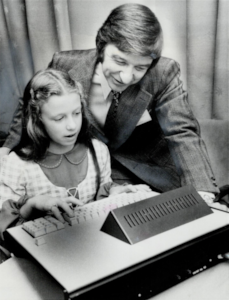

The MCM/70 computer was designed by MCM in the period between 1972 and 73. It was possibly the earliest example of a microprocessor-powered computer designed and manufactured specifically for personal use. MCM's business plan was to capture a sizable share of the computer and programmable calculator markets by offering the world's first desktop, microprocessor-based, mass-manufactured computer for personal use.
The MCM/70 was a brainchild of a Canadian entrepreneur and inventor Mers Kutt. It was a small `all-in-one' computer of the size of a typical typewriter of the time, weighting approximately 20 lbs. Its well-designed case had a built in 51-key keyboard, up to two optional digital cassette drives, and a small plasma display panel. The panel could display 32 characters in a single line; the `moving window' feature allowed for up to 85 characters to be entered and viewed in a single line. The cassette drives provided both external storage (over 100 Kbytes per drive) as well as virtual memory. José Laraya was the main hardware engineer behind the MCM/70 project.
MCM maintained that society's direct and unrestricted access to computers could be accomplished with affordable personal computing devices bundled with user-friendly operating systems and powerful but simple programming languages. That's why the MCM/70 was offered with a built-in operating system and the MCM/APL computer language.
The MCM/APL was a dialect of the APL programming language released by IBM in the late 1960s. It was designed by Gordon Ramer who, before joining MCM from York University, authored another APL dialect–York APL–which was successfully used at various North American and European institutions.
The MCM/70's operating system designed primarily by André Arpin, comprised of EASY (External Allocation SYstem) and AVS (A Virtual System) software. EASY provided traditional input and output functions for digital cassette-based storage. Data and APL programs could be stored, listed, modified, retrieved, and deleted. EASY controlled mounting and unmounting of cassette tapes; it also controlled the execution of APL programs allowing the user to, for instance, suspend and unsuspend such executions. On the other hand, AVS provided virtual memory by swapping programs and data between the computer's internal memory and a digital cassette mounted in one of the tape drives of the computer-- a technique that allowed the execution of programs that otherwise would require much more memory than the Intel 8008 microprocessor inside the MCM/70 could operate with directly.
The MCM/70 offered several novel features including the above mentioned built-in operating system, a programming language, and virtual memory. Another unique feature was a power failure protection system designed by Edward Edwards. It allowed continuous operation under battery power in the event of power failure. For extended power loss, the computer initiated an orderly shutdown by automatically executing a system back-up and copying the content of memory to a cassette. The system was automatically reinstated as though there was no interruption at all when the power was restored and batteries were recharged.
The MCM/70 could drive a printer. Later, with the introduction of the improved model /700 in 1975, a range of other peripherals were offered: external displays (the VDU-2480 and VDU-9620), floppy disk drive systems (the SDS-250 and DDS-500), a card reader (the PMR-400), and a communications modem.
From 1974, the MCM/70s were sold in North America and Europe. The computer was acquired by, among other corporations and organizations, Chevron Oil Research Company, Firestone, Toronto Hospital for Sick Children, Mutual Life Insurance Company of New York, Ontario Hydro-Electric Power Commission, NASA Goddard Space Flight Centre, and the United States Army.
MCM coined the term "personal computer" in its early promotional literature and manuals:
The simplicity of the MCM/70 and its associated computer language (known as APL) make personal computer use and ownership a reality... Enjoy the privilege of having your own personal computer – it's a privilege no computer user has ever had before the MCM/70... Good luck, and welcome to the computer age! [MCM/70 User's Manual, 1973]
